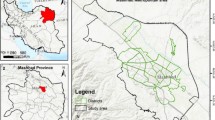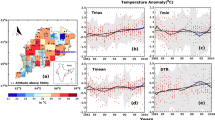Abstract
We investigated the seasonal variability of the relationships between land surface temperature (LST) and land use/land cover (LULC) variables, and how the spatial and thematic resolutions of LULC variables affect these relationships. We derived LST data from Landsat-7 Enhanced Thematic Mapper (ETM+) images acquired from four different seasons. We used three LULC datasets: (1) 0.6 m resolution land cover data; (2) 30 m resolution land cover data (NLCD 2001); and (3) 30 m resolution Normalized Difference Vegetation Index data derived from the same ETM+ images (though from different bands) used for LST calculation. We developed ten models to evaluate effects of spatial and thematic resolution of LULC data on the observed relationships between LST and LULC variables for each season. We found that the directions of the effects of LULC variables on predicting LST were consistent across seasons, but the magnitude of effects, varied by season, providing the strongest predictive capacity during summer and the weakest during winter. Percent of imperviousness was the best predictor on LST with relatively consistent explanatory power across seasons, which alone explained approximately 50 % of the total variation in LST in winter, and up to 77.9 % for summer. Vegetation related variables, particularly tree canopy, were good predictor of LST during summer and fall. Vegetation, particularly tree canopy, can significantly reduce LST. The spatial resolution of LULC data appeared not to substantially affect relationships between LST and LULC variables. In contrast, increasing thematic resolution generally enhanced the explanatory power of LULC on LST, but not to a substantial degree.



Similar content being viewed by others
References
Akaike H (1978) On the likelihood of a time series model. Stat 27:217–235
Akbari H, Pomerantz M, Taha H (2001) Cool surfaces and shade trees to reduce energy use and improve air quality in urban areas. Sol Energy J 70:295–310
Alhamad MN, Alrababah MA, Feagin RA, Gharaibeh A (2011) Mediterranean drylands: the effect of grain size and domain of scale on landscape metrics. Ecol Indic 11:611–621
Arnfield AJ (2003) Two decades of urban climate research: a review of turbulence, exchanges of energy and water, and the urban heat island. Int J Climatol 23:1–26
Balling RC, Brazel SW (1988) High resolution surface temperature pattern in a complex urban terrain. Photogramm Eng Remote Sens 54:1289–1293
Barsi JA, Schott JR, Palluconi FD, Hook SJ (2005). Validation of a web-based atmospheric correction tool for single thermal band instruments. Earth observing systems X. In: Proceedings of SPIE Vol. 5882, San Diego, CA
Ben-Dor E, Saaroni H (1997) Airborne video thermal radiometry as a tool for monitoring microscale structures of the urban heat island. Int J Remote Sens 18(4):3039–3053
Burnham KP, Anderson DR (2002) Model selection and multimodel inference: a practical information-theoretic approach. Springer, New York
Buyantuyev A, Wu J (2010) Urban heat islands and landscape heterogeneity: linking spatiotemporal variations in surface temperatures to land-cover and socioeconomic patterns. Landscape Ecol 25(1):17–33
Connors JP, Galletti CS, Chow WTL (2012) Landscape configuration and urban heat island effects: assessing the relationship between landscape characteristics and land surface temperature in Phoenix, Arizona. Landscape Ecol. doi:10.1007/s10980-012-9833-1
Duneier M (2006) Ethnography, the ecological fallacy, and the 1995 Chicago heat wave. Am Sociol Rev 71:679–688
Greenfield EJ, Nowak DJ, Walton J (2009) Assessment of 2001 NLCD percent tree and impervious cover estimates. Photogram Eng Remote Sens 75(11):1279–1286
Guhathakurta S, Gober P (2007) The impact of the Phoenix urban heat island on residential water use. J Am Plan Assoc 73:317–329
Homer C, Huang C, Yang L, Wylie B, Coan M (2004) Development of a 2001 National Land Cover Database for the United States. Photogram Eng Remote Sens 70(7):829–840
Huang GW, Zhou, Cadenasso ML (2010) Understanding the relationship between urban land surface temperature, landscape heterogeneity and social structure. In: Proceedings of the 2010 IEEE international geoscience and remote sensing symposium, 3933–3936
Huang G, Zhou W, Cadenasso ML (2011) Is everyone hot is the city? Spatial pattern of land surface temperatures, land cover and neighborhood socioeconomic characteristics in Baltimore city, MD. J Environ Manag 92(7):1753–1759
Jenerette GD, Harlan SL, Brazel A, Jones N, Larsen L, Stefanov WL (2007) Regional relationships between surface temperature, vegetation, and human settlement in a rapidly urbanizing ecosystem. Landscape Ecol 22:353–365
Jenerette GD, Harlan SL, Stefanov WL, Martin CA (2011) Ecosystem services and urban heat riskscape moderation: water, green spaces, and social inequality in Phoenix, USA. Ecol Appl 21:2637–2651
Klinenberg E (2002) Heat Wave: a social autopsy of disaster in Chicago. University of Chicago Press, Chicago
Landsat Project Science Office. Landsat 7 Science Data Users Handbook (2009). Available via http://landsathandbook.gsfc.nasa.gov/handbook.html. Accessed on 22 Oct 2010
Lechner AM, Langford WT, Bekessy SA, Jones SD (2012) Are landscape ecologists addressing uncertainty in their remote sensing data? Landscape Ecol 27(9):1249–1261
Li J, Song C, Cao L, Zhu F, Meng X, Wu J (2011) Impacts of landscape structure on surface urban heat islands: a case study of Shanghai, China. Remote Sens Environ 115:3249–3263
Li X, Zhou W, Ouyang Z, Xu W, Zheng H (2012) Spatial pattern of greenspace affects land surface temperature: evidence from the heavily urbanized Beijing metropolitan area, China. Landscape Ecol 27:887–898
Liu H, Weng Q (2009) Scaling-up effect on the relationship between landscape pattern and land surface temperature. Photogram Eng Remote Sens 75(3):291–304
Lo CP, Quattrochi DA (2003) Land-use and land-cover change, urban heat island phenomenon, and health implications: a remote sensing approach. Photogram Eng Remote Sens 69(9):1053–1063
Lu D, Hetricka S, Morana E (2011) Impervious surface mapping with quickbird imagery. Int J Remote Sens 32(9):2519–2533
Myint S, Wentz E, Brazel A, Quatrochi D (2013) The impact of distinct anthropogenic and vegetation features on urban warming. Landscape Ecol 28:959–978
Nichol JE (1994) A GIS-based approach to microclimate monitoring in Singapore’s high-rise housing estates. Photogram Eng Remote Sens 60:1225–1232
Nichol JE (1996) High-resolution surface temperature patterns related to urban morphology in a tropical city: a satellite-based study. J Appl Meteorol 35:135–146
Nichol JE (1998) Visualisation of urban surface temperatures derived from satellite images. Int J Remote Sens 19(9):1639–1649
Nichol JE, Fung WY, Lam K, Wong MS (2009) Urban heat island diagnosis using ASTER satellite images and ‘in situ’ air temperature. Atmos Res 94(2):276–284
Nowak DJ, Greenfield EJ (2010) Evaluating the national land cover database tree canopy and impervious cover estimates across the conterminous United States: a comparison with photo-interpreted estimates. Environ Manag 46:378–390
Oke TR (1995) The heat island of the urban boundary layer: characteristics, causes and effects. In: Cermak JE (ed) Wind climate in cities. Kluwer Academic Publishers, Netherlands, pp 81–107
Pu R, Gong P, Michishita R, Sasagawa T (2006) Assessment of multi-resolution and multi-sensor data for urban surface temperature retrieval. Remote Sens Environ 104:211–225
Quattrochi DA, Luvall JC (1999) Thermal infrared remote sensing for analysis of landscape ecological processes: methods and applications. Landscape Ecol 14:577–598
Shao G, Wu J (2008) On the accuracy of landscape pattern analysis using remote sensing data. Landscape Ecol 23:505–511
Smith MA, Zhou W, Cadenasso M, Grove M, Band L (2010) Evaluation of the national land cover database for hydrologic applications in urban and suburban Baltimore Maryland. J Am Water Resour Assoc 46(2):429–442
Snyder W, Wan Z, Zhang Y, Feng Y, Feng Z (1998) Classification-based emissivity for land surface temperature measurement from space. Int J Remote Sens 19:2753–2774
Sun RH, Chen AL, Chen LD, Lü YH (2012) Cooling effects of wetlands in an urban region: the case of Beijing. Ecol Indic 20:57–64
University of Maryland (UMD) (2001) Normal precipitation and temperature values for Baltimore city from 1961 to 1990. Baltimore, Maryland
Voogt JA, Oke TR (2003) Thermal remote sensing of urban climates. Remote Sens Environ 86:370–384
Weng Q, Lu D, Schubring J (2004) Estimation of land surface temperature—vegetation abundance relationship for urban heat island studies. Remote Sens Environ 89:467–483
White MA, Nemani RR, Thornton PE, Running SW (2002) Satellite evidence of phenological differences between urbanized and rural areas of the eastern United States deciduous broadleaf forest. Ecosystems 5:260–277
Wu J (2004) Effects of changing scale on landscape pattern analysis: scaling relationships. Landscape Ecol 19:125–138
Yuan F, Bauer ME (2007) Comparison of impervious surface area and normalized difference vegetation index as indicators of surface urban heat island effects in Landsat imagery. Remote Sens Environ 106:375–386
Zhou W, Troy A (2008) An object-oriented approach for analyzing and characterizing Urban landscape at the parcel level. Int J Remote Sens 29:3119–3135
Zhou W, Troy A (2009) Development of an object-based framework for classifying and inventorying human-dominated forest ecosystems. Int J Remote Sens 30(23):6343–6360
Zhou W, Huang G, Cadenasso ML (2011) Does spatial configuration matter? Understanding the effects of land cover pattern on land surface temperature in urban landscapes. Landscape Urban Plan 102(1):54–63
Acknowledgments
The support of the State Key Laboratory of Urban and Regional Ecology, Research Center for Eco-Environmental Sciences, Chinese Academy of Sciences, is gratefully acknowledged. This research also was supported by the National Science Foundation LTER program (DEB 042376). The authors would like to thank the editor and the anonymous reviewers for their helpful comments and suggestions. Comments from Dr. Brian Voigt improved the early draft of this manuscript.
Author information
Authors and Affiliations
Corresponding author
Electronic supplementary material
Below is the link to the electronic supplementary material.
Rights and permissions
About this article
Cite this article
Zhou, W., Qian, Y., Li, X. et al. Relationships between land cover and the surface urban heat island: seasonal variability and effects of spatial and thematic resolution of land cover data on predicting land surface temperatures. Landscape Ecol 29, 153–167 (2014). https://doi.org/10.1007/s10980-013-9950-5
Received:
Accepted:
Published:
Issue Date:
DOI: https://doi.org/10.1007/s10980-013-9950-5




